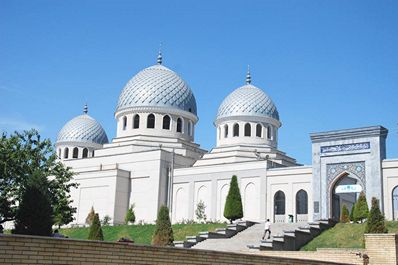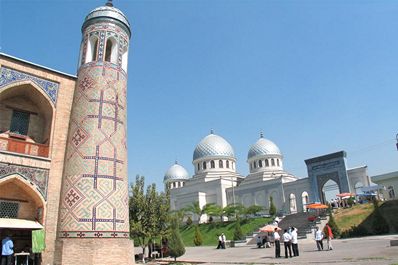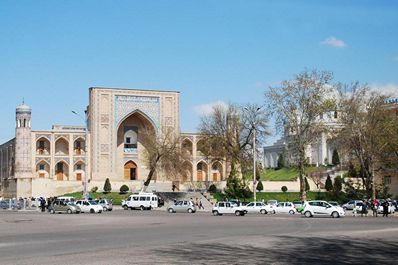Khoja Akhrar Vali Juma Mosque, Tashkent
History of the Khoja Akhrar Vali Juma Mosque. Friday Prayer
The foundation of the first Friday Cathedral Mosque in Tashkent (Juma mosque) was established in 819, at the highest point of the “shakhristan” (centre) of ancient Tashkent. Up to now, the Mosque repeatedly rebuild, renamed and restored in different epochs is still overlooked in the Old City and surrounded with the Chorsu, Khadra and Eski Juva places.
This Juma mosque is the most ancient among 157 mosques of modern Tashkent and the third largest one in Uzbekistan after the Bibi-Khanum in Samarkand and Poi-Kalyan in Bukhara. From the XV century till now, the mosque was named after one of the Sufi leaders of the oriental Middle Ages - Khoja Akhrar Vali, who presented the city with this building built on the foundation of the old Juma-mosque (Juma-mosque means a Friday mosque) in 1451.
The Khoja Akhrar Vali mosque was built in a form of 15-m cube which symbolizes the holy Kaaba, with a dome and arch span, open to the East. In pre-revolutionary Tashkent with its low-rise one- and two-storey houses, the Khoja Akhrar Vali mosque was the highest building from where the whole city could be observed.
The Juma-mosque building like those of the other Muslim mosques was oriented to the cardinal points and faced to the direction of Mecca (south-western direction from Tashkent). Anciently, it was a popular belied that in case of non-observance of this construction rule, no prayer would reach Allah.
Inside the cube, there was a mikhrab and a place for Imam. Also inside it, there were arched galleries with cells built around a long yard; a takhoratkhona is a place where the Muslims are performing ablutions before prayer. The mosque finish was ordinary without any rich decoration in order nothing could distract the faithful Muslim from his prayer, wherefore the women who only had the right to visit cemeteries and speak to a sheik rather than an imam, were not allowed to mosques.
It should be noted that the Friday prayer has special importance for the Muslims even now and its visiting was obligatory for every believer. In medieval Tashkent there existed a service of mukhtasibs who had the right to chastise a Muslim by caning who did not appear at one o’clock for the Friday prayer.
The procedure of the Friday prayer is following. At the time for praying a muezzin from the tower is calling the Muslim out. The believers are performing ablutions (takhorat) before prayer. Then they are aligning, shoulder by shoulder with their faces to Mecca. A mikhrab - an ambry with inscriptions from the Koran - next to the Imam arch-see, sets the direction.
At one o’clock sharp, the Imam rises to the arch-see. An Imam is not a priest, normally he is chosen from among the believer to manage the namaz (prayer) reading. It is only him who has the right to stay with his back to Mecca during the namaz. The Imam is reciting by heart surahs from the Koran while the believers are following the paryer by rakats – prostrations. There are lying, sitting and standing positions in rakats. In order to make namaz reading more comfortable the Muslims bring small prayer rugs – joy-namaz.
The prayer lasts a short time, on average, it takes 20 minutes. Upon completion of the payer the believers are turning together to the right to greet Allah. Then they are turning to the left to do the same. Thereupon the Friday prayer finishes.
During every Friday prayer, the Muslims are reading a khutbah - a peroration - to the country’s ruler. Its reading is obligatory otherwise the prayer is not valid.
There are five clock faces with movable hands in every Muslim mosque, twice a day, praying hours for the believers are set on them. Since the Muslims are praying 5 times a day at equal intervals, the daylight of each day is divided into five equal parts to establish the exact time for praying.
In the XV century, opposite to the central entry of the mosque there was a one-storey building which does not exist now. Five centuries later after construction of the Khoja Akhrar Vali mosque, the madrasah was unbricked by the municipal authorities for restoration of the neighboring houses.
The Khoja Akhrar Vali mosque underwent a serious reconstruction in the XVIII and XIX centuries after catastrophic earthquakes which caused a damage to many buildings of the city. Following the earthquake of 1868, the mosque was left completely destroyed for 20 years, until the Russian emperor Alexander III assigned money for its restoration in the year of 1888. That is why it was called a Tsarist Mosque, for a long time after its restoration. In the Soviet period this Juma mosque was confiscated and used as an administrative building for the Ministry of Education and later by other public offices. The main cathedral mosque of Tashkent through a semicentenary was the Tillya Mosque on the Khast-Imam Place.
The last restoration of the Khoja Akhrar Vali mosque was performed in 90-s of the last century. The building was rebuilt anew by modern architects, its cube was demolished and instead of one dome there are three domes crowning the mosque now. The architectural ensemble surrounded the Khoja Akhrar Vali Juma Mosque except for the restored Kukeldash madrasah and a dome of the mahalla Gulbazar mosque, did not survive up to this date. One can only have an idea of the original appearance of this complex now by old pictures and photos.




